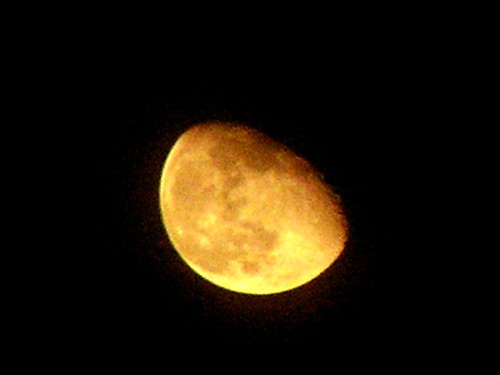Photographing the moon can be a daunting task. There are several tips I can give about photographing the moon.
 Pick a Clear Night - This is very important. Any haze, clouds, wisps, or fog can ruin a shot. The less atmosphere you shoot through, the better the picture will be.
Pick a Clear Night - This is very important. Any haze, clouds, wisps, or fog can ruin a shot. The less atmosphere you shoot through, the better the picture will be.- Know Your Phases - Knowing the phase of the moon is crucial for what to expect in the resulting photograph. A full moon gives great pictures of features on the moon's surface, but half moons create shadows on the moon's surface that results in better definition.
- Know Your Camera Settings - The single most important fact of moon photography is a rudimentary understanding of your f stops, ISO, and shutter speed. The "auto-picture setting" features on most digital cameras will create a bright blur in the sky with absolutely no detail visible. It is possible to take great photos without the need of a tripod with the correct settings. Use a lower ISO setting to reduce noise, a shorter shutter speed to reduce blurring and negate the need for a remote shutter, and a higher aperture (f/stop) to collect as much light as possible in the short amount of time allowed by the camera to create the photograph. Focus on infinity.
 Know Where The Moon Is In The Sky - This is a basic one, but still an important one. If you have a clear view of the horizon, when the moon is rising at night time, you will get a deep orange color. As it rises it will become more of a yellowish color, and it will eventually become the bluish-white color we generally think of when we think of the moon. Depending on what you are going for, keep this in mind.
Know Where The Moon Is In The Sky - This is a basic one, but still an important one. If you have a clear view of the horizon, when the moon is rising at night time, you will get a deep orange color. As it rises it will become more of a yellowish color, and it will eventually become the bluish-white color we generally think of when we think of the moon. Depending on what you are going for, keep this in mind.- Trial and Error - Experiment with different settings and record their results in a notebook, or even on back of the finished photographs. Get a feel for your camera; I can't provide exact settings because every camera is different. Keep this in mind: auto-picture won't work; you're gonna have to go all manual.




|